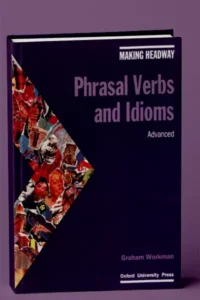Making Headway-Phrasal Verbs and Idiom (Upper-Intermediate): is a supplementary series for teachers and students of English. It is created to complement the Headway coursebook, but can also be used with other main coursebooks.
Making Headway Phrasal Verbs and Idioms
This book is for students who are studying Headway Advanced or any other coursebook at a similar level. It can also be used by students who are preparing for Cambridge CAE or CPE examinations.
The materials in each unit are organized around themes such as personal relationships, money, describing people, health, reviewing books and films. etc. The units are free-standing and can therefore easily be used to supplement a range of coursebooks. As with Phrasal Verbs and Idioms Upper-Intermediate, the book is designed to present multi-word verbs in context and illustrate how they are used.
The book contains over 120 multi-word verbs. They have been selected according to the theme of each unit, as well as the level of difficulty and usefulness. Practice exercises are provided for consolidation work. Idiomatic expressions which relate to the theme of the unit are also presented and practised.
How to use the Book?
Learn how you can use this book.
To the teacher:
- We recommend you use the Introductory unit before any other units in the book. All the units contain enough material for approximately 90 minutes of classroom work.
- Units 1-it) follow a pattern:
- The Preparation section is designed as a brief lead-in to the theme of the unit, not lasting more than five minutes.
- The Presentation is usually a listening or reading text. followed by Checking Understanding. an activity where the multi-word verbs introduced are matched with specially written definitions.
- The Drills provide controlled oral practice of the new multi-word verbs. They can be used after the Checking Understanding activity, or later, as revision. The drills can be played on cassette, or the teacher can read them aloud in class.
- The Practice section provides controlled and semi-controlled practice activities for the multi-word verbs introduced in the unit. There are also exercises designed to encourage students to explore the collocations of some multi-word verbs. This section includes practice exercises for idiomatic expressions.
- How multi-word verbs work provides practice in identifying the different types of multi-word verbs, and looks at the general meaning of some particles when used with certain verbs.
- The section What’s the answer? is designed to check that students have understood the important differences between some of the multi-word verbs. It can be used as a game or revision activity.
- The Jokes provide some light relief. They are related to the theme of the unit and sometimes illustrate humorous uses of multi-word verbs.
- The Speaking section is designed to provide freer practice of the new multi-word verbs and idiomatic expressions, and gives students the opportunity to use them to talk about their own experiences and ideas. It is sometimes connected to the writing task which follows. This section can be used in a subsequent lesson after students have had time to revise and absorb the new language in the unit.
- The Writing section provides further consolidation of the language covered in the unit, and is probably best set as homework.
- Unit 11 is an exception to this pattern. It deals exclusively with Proverbs. At the back of the book, the Tapescript is a useful reference point for students to consult. The Answer key provides answers to all the exercises. useful definitions for the idiomatic expressions, and helpful guidance on collocation.
- It is important that students are given some activities for revising the multi-word verbs they learn in the book. The Drills section can be used. and a simple revision activity is for students in pairs to test each other using the definitions in Checking understanding. Some multi-word verbs and idioms can be used in a Find someone who… activity as a warmer at the start of a lesson. Pairs of students can devise clues for a multi-word verb crossword which can then be used to test other students. Students can be asked to act out some of the dialogues on tape, and their spoken and written errors with multi-word verbs can be used in a Grammar Auction game.
To the student working independently
- Read and listen to the presentation reading and listening texts, using the cassette and the tapescripts. Then do the exercises which follow.
- Test yourself by listening and responding to the drills on the cassette. Alternatively, use the tapescript of the drills — you can cover up the answer and see if you produce the right response.
- Work through the written exercises in the book and check your answers in the Answer key.
- Find a friend to practise the spoken exercises with, or write out what you would say.
- Do the free writing activities and then find someone who can correct them.
You can Also Read: New Headway Advanced (PDF, Audio, Video)


